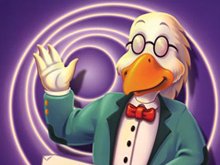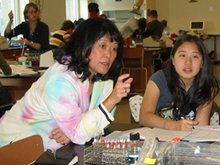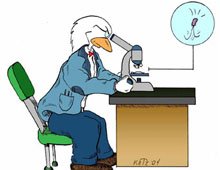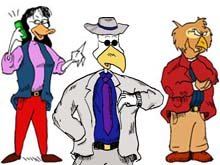Dr. Birdley Teaches Science


Nevin Katz '99 is a curriculum developer and teacher who lives in Amherst, Mass., with his wife, Melissa, and son, Jeremy. After majoring in biology at Swarthmore, he earned his M.Ed. at the Harvard Graduate School of Education. Nevin has taught biology, chemistry, and other science courses in grades 6 through 11 and currently teaches at Ludlow High School in Ludlow, Mass. Write to him at nevkatz@gmail.com
 hen I first arrived at Swarthmore, I brought with me an interest in both the arts and sciences and was looking forward to exploring both areas further. I was fascinated by my introductory biology course in Martin Hall, and I chose to major in the subject while taking a range of humanities courses. As I went through my four years and became interested in chemistry, neurobiology, and evolution, I often returned to my habit of sketching and writing that I had started at a young age. The liberal arts nature of Swat enabled me to stay acutely tuned into the arts as well as the sciences, and even combine the two at certain points. By my senior year, I was looking for a career that would allow me to draw on both worlds.
hen I first arrived at Swarthmore, I brought with me an interest in both the arts and sciences and was looking forward to exploring both areas further. I was fascinated by my introductory biology course in Martin Hall, and I chose to major in the subject while taking a range of humanities courses. As I went through my four years and became interested in chemistry, neurobiology, and evolution, I often returned to my habit of sketching and writing that I had started at a young age. The liberal arts nature of Swat enabled me to stay acutely tuned into the arts as well as the sciences, and even combine the two at certain points. By my senior year, I was looking for a career that would allow me to draw on both worlds.It was not until I started teaching biology and chemistry shortly after college that I discovered how thin the line was between art and science. While teaching high school in an urban district of Western Massachusetts, I re-discovered the comics medium, which until then had been a relic from my childhood. Nonetheless, I read a few non-fiction graphic novels and started to think about the potential of the medium to convey complex science ideas in my classroom.

Subjects addressed in the Dr. Birdley series include cells, properties of matter, and atomic structure, with ecology, forces and motion, and the history of the Earth soon to come.
The character, now known as Dr. Birdley, has remained in my world ever since and for the past six years, I have been authoring and illustrating a series of comics-based science resource books that feature him as the central figure. The series, "Dr. Birdley Teaches Science," contains comics and other visually-based science resources that I first designed for my classes to make science more accessible for my students.
Since the time of Dr. Birdley's genesis, the need for these types of materials has been clear to me. Having had many classes where my students are at a diverse range of reading levels and often feel intimidated by heavy science content, I have found that the comics medium opens doors for them. A science comic enables me to take some of the most intricate, complex ideas I had initially learned at Swarthmore, distill them down to their essentials, and convey them clearly to a young audience, either at the high school or middle school level. I first used these comics in a high school chemistry class and was impressed with how engaged the students were as we were reading them. As I use them today, I find that a memorable scenario in a comic, such as Dr. Birdley talking to a microbe, gives us a concrete event to come back to as we review for an exam.

Professor of Biology Amy Cheng Vollmer (left) still teaches the course that Nevin says provided a memorable opportunity to combine science and media.
One of the most memorable opportunities to combine science and media was in my Pathogenesis and Immune Response course, taught by Professor of Biology Amy Cheng Vollmer. At one point, Amy asked if anyone would be interested in designing a video featuring an interpretive dance of an immune response pathway, known as compliment fixation. The idea was to write and direct a choreographed performance in which students acted out the process by playing such parts as the complement proteins and parts of the bacteria cell. I expressed an interest in this rare opportunity and had the good fortune of working with Ann Willman '01 (now Ann Silk) in researching the material, writing a script, and coordinating the performance. We asked various students to lend their talents, filmed the performance in the late spring, and met to edit the video that summer. Later, I was flattered to hear after graduation that the video was being used in Swarthmore's introductory biology course.

The Dr. Birdley series is populated not just with Nevin's alter ego, but also with...
Within each unit of a given book, I supplement the comics with a variety of exercises that break down the information with a series of visual images. It was my chemistry courses at Swarthmore that first got me to start thinking about how the processes of learning and problem solving happen. These courses were at first overwhelming, but at some point the light went on and I started enjoying the struggle - mainly because I was learning how to break down something like a reaction mechanism into more basic parts, or categorize a reaction as a particular type of problem and then draw on the matching strategy for solving it. By the time I started teaching, I used the basic ideas behind these techniques to help my students develop an understanding of visual problem-solving strategies, similar to those I had learned in chemistry. I was able to draw on these strategies in designing the graphic organizers, background sections, and visual exercises that round out a given book.

... a cast of characters that includes Clarissa, a science reporter, friend Jaykes, and Owelle, the crabby dean.


